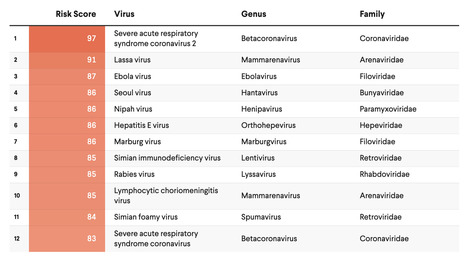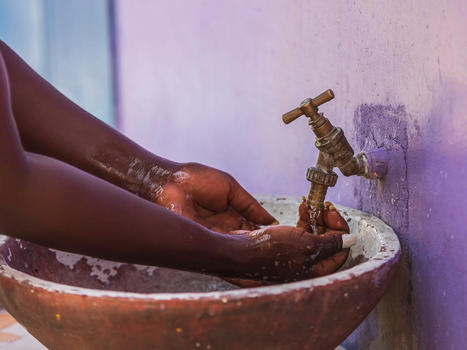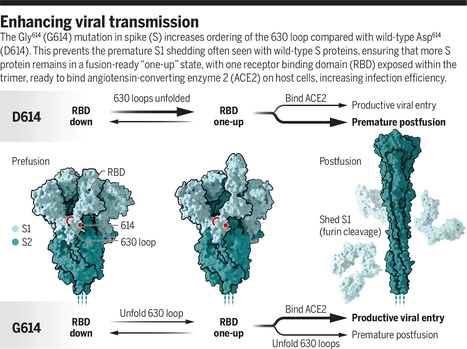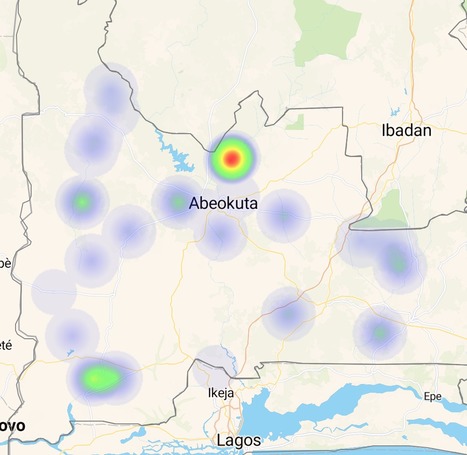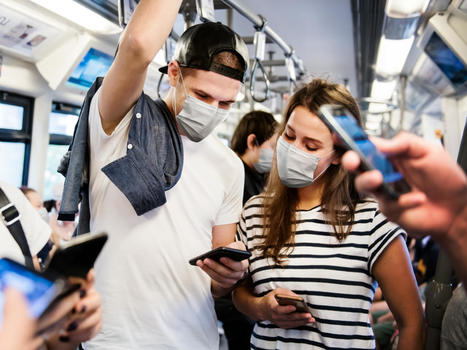 Your new post is loading...
 Your new post is loading...
The past several decades have seen an alarming spike in communicable disease outbreaks worldwide. Given a confluence of host, virologic, environmental, and human factors, experts agree that the next pandemic could already be on the horizon. In a globalized world, changes in how people use land and interact with their ecosystems—such as rapid deforestation and agricultural expansion—have resulted in humans and animals coming into more frequent and intense contact with one another, increasing opportunities for what is known as "zoonotic disease spillover." In the past few years alone, numerous disease outbreaks have had suspected or confirmed zoonotic origin, including mpox (formerly known as monkeypox), Ebola virus disease, dengue fever, and COVID-19. Experts also recognize the need to prepare for another possible Disease X, a term used to describe a currently unknown pathogen with pandemic potential. To direct resources toward the most high-consequence pathogens, it is paramount that leaders have an accurate concept of pandemic risk—for individual viruses as well as viral families. Several institutions are developing disease rankings at national and global levels, including the Priority Zoonotic Diseases Lists facilitated by the U.S. Centers for Disease Control and Prevention and the Research and Development (R&D) Blueprint created by the World Health Organization. The original SpillOver risk ranking framework (SpillOver 1.0), an open-source webtool launched by researchers at the University of California, Davis One Health Institute, estimated the relative spillover potential of wildlife-origin viruses to humans based on a series of host, viral, and environmental risk factors determined via expert opinion and scientific evidence. Its next iteration, SpillOvers 2.0, has rebranded to better describe the diversity and frequency of virus spillovers to people. The new platform uses a One Health approach, which recognizes the interdependence of human, animal, and environmental health. It will expand to include domestic animal and vector-borne viruses and assess pandemic risk rather than just spillover risk for wildlife viruses.

|
Scooped by
nrip
|
Background: In March 2020, South Africa implemented strict nonpharmaceutical interventions (NPIs) to contain the spread of COVID-19. Over the subsequent 5 months, NPI policies were eased in stages according to a national strategy. COVID-19 spread throughout the country heterogeneously; the case numbers peaked from July to August. A second COVID-19 wave began in late 2020. Data on the impact of NPI policies on social and economic well-being and access to health care are limited.
Objective: We aimed to determine how rural residents in three South African provinces changed their behaviors during the first COVID-19 epidemic wave.
Methods: The South African Population Research Infrastructure Network nodes in the Mpumalanga (Agincourt), KwaZulu-Natal, (Africa Health Research Institute) and Limpopo (Dikgale-Mamabolo-Mothiba) provinces conducted up to 14 rounds of longitudinal telephone surveys among randomly sampled households from rural and periurban surveillance populations every 2-3 weeks. Interviews included questions on the following topics: COVID-19–related knowledge and behaviors, the health and economic impacts of NPIs, and mental health. We analyzed how responses varied based on NPI stringency and household sociodemographics.
Conclusions: South Africans complied with stringent, COVID-19–related NPIs despite the threat of substantial social, economic, and health repercussions. Government-supported social welfare programs appeared to buffer interruptions in income and health care access during local outbreaks. Epidemic control policies must be balanced against the broader well-being of people in resource-limited settings and designed with parallel support systems when such policies threaten peoples’ income and access to basic services.

|
Scooped by
nrip
|
The WHO Hub for Pandemic and Epidemic Intelligence will be a global platform for pandemic and epidemic intelligence, creating shared and networked access to vital multi-sectoral data, driving innovations in data analytics and building the communities
of practice needed to predict, prevent, detect, prepare for and respond to worldwide health threats. The WHO Hub will be a new global collaboration of countries and partners worldwide, driving innovations to increase availability and linkage of diverse data; develop tools and predictive models for risk analysis; and to monitor disease control measures
and infodemics. The WHO Hub will enable partners from around the world to collaborate and co-create the tools and data access that all countries need to prepare, detect and respond to pandemic and epidemic risks. The World Health Organization (WHO) and the Federal Republic of Germany will establish a new global hub for pandemic and epidemic intelligence, data, surveillance and analytics innovation. The Hub, based in Berlin and working with partners around the
world, will lead innovations in data analytics across the largest network of global data to predict, prevent, detect prepare for and respond to pandemic and epidemic risks worldwide. Critically, the WHO Hub will support the work of public health experts and policy-makers in all countries with insights so
they can take rapid decisions to prevent and respond to future public health emergencies.“We need to identify pandemic and epidemic risks as quickly as possible, wherever they occur in the world. For that aim, we need to strengthen the global early warning surveillance system with improved collection of health-related data and inter-disciplinary risk analysis,” said Jens Spahn, German Minister of Health. Working with partners globally, the WHO Hub will drive a scale-up in innovation for existing forecasting and early warning capacities in WHO and Member States. At the same time, the WHO Hub will accelerate global collaborations across public and private sector organizations, academia, and international partner networks. It will help them to collaborate and co-create the necessary tools for managing and analyzing data for early warning surveillance. It will also promote greater access to data and information. “One of the lessons of COVID-19 is that world needs a significant leap forward in data analysis to help leaders make informed public health decisions,” said Dr Tedros Adhanom Ghebreyesus, WHO Director-General. “This requires harnessing the potential of advanced technologies such as artificial intelligence, combining diverse data sources, and collaborating across multiple disciplines. Better data and better analytics will lead to better decisions.” read the release at the WHO website at https://www.who.int/news/item/05-05-2021-who-germany-launch-new-global-hub-for-pandemic-and-epidemic-intelligence also useful to read the note on the UN website about the same https://news.un.org/en/story/2021/05/1091332

|
Scooped by
nrip
|
Viruses need entry proteins to penetrate the cells where they will replicate. The severe acute respiratory syndrome coronavirus 2 (SARS-CoV-2) version is called the spike or S protein. The S protein, also the target of the current vaccines, is quickly adapting to its new human hosts. It took its first major step in this direction early in 2020, when its amino acid 614 (of 1297) changed from an aspartic acid (D) to a glycine (G). Viruses bearing this D614G mutation transmit among humans more rapidly and now form the majority in circulation. On page 525 of this issue, Zhang et al. (1) use careful structural analyses to reveal how D614G changed the S protein to accelerate the pandemic. The work of Zhang et al. also reveals more about the natural history of the virus. The notable emergence of D614G suggests that the acquisition of a destabilizing furin site was a recent event. The virus could easily lose this site, as it does frequently in cell culture systems, implying that it in some way facilitates human transmission. This is not a conclusion that most students of human coronaviruses would have anticipated, given that SARS-CoV-1, which transmits with reasonable efficiency, lacks this site, whereas the more distantly related MERS coronavirus bears this site and transmits poorly. How the SARS-CoV-2 furin site promotes new human infections remains a key open question in the field. read the entire article at https://science.sciencemag.org/content/372/6541/466

|
Scooped by
nrip
|
Several new viral respiratory tract infectious diseases with epidemic potential that threaten global health security have emerged in the past 15 years. In 2003, WHO issued a worldwide alert for an unknown emerging illness, later named severe acute respiratory syndrome (SARS). The disease caused by a novel coronavirus (SARS-CoV) rapidly spread worldwide, causing more than 8000 cases and 800 deaths in more than 30 countries with a substantial economic impact. Since then, we have witnessed the emergence of several other viral respiratory pathogens including influenza viruses (avian influenza H5N1, H7N9, and H10N8; variant influenza A H3N2 virus), human adenovirus-14, and Middle East respiratory syndrome coronavirus (MERS-CoV). In response, various surveillance systems have been developed to monitor the emergence of respiratory-tract infections. These include systems based on identification of syndromes, web-based systems, systems that gather health data from health facilities (such as emergency departments and family doctors), and systems that rely on self-reporting by patients. More effective national, regional, and international surveillance systems are required to enable rapid identification of emerging respiratory epidemics, diseases with epidemic potential, their specific microbial cause, origin, mode of acquisition, and transmission dynamics.
|

|
Scooped by
nrip
|
The pandemics of major infectious diseases often cause public health, economic, and social problems. Virtual reality (VR) and augmented reality (AR), as two novel technologies, have been used in many fields for emergency management of disasters. The objective of this paper was to review VR and AR applications in the emergency management of infectious outbreaks with an emphasis on the COVID-19 outbreak. It appears that VR and AR technologies can play a positive role during infectious disease outbreaks. VR and AR have been widely used in the prevention and response phases of emergency management during infectious disease pandemics, such as SARS and Ebola pandemics, especially for educating and training purposes for the public. During the COVID-19 outbreak, these technologies have the potential to be used in various fields, including 1) clinical context (e.g., telehealth, drug discovery, patient assessment, mental health management), 2) entertainment (e.g., video call, meditation, gaming), 3) business and industry (e.g., holding meetings and conferences, marketing), and 4) education (e.g., in schools and universities, for healthcare providers, and VR-based content for improving public health). These technologies can be used in the above-mentioned fields by providing their different features for facilitating the challenges of COVID-19. However, to respond to COVID-19, all applications of VR and AR should be considered as a supportive approach alongside other information technologies. We believe that VR and AR have a substantial potential to impact the emergency management of COVID-19 or any infectious disease pandemics; however, these potentials need to be studied in a more robust manner. read the paper ta https://www.sciencedirect.com/science/article/pii/S2352914821000691

|
Scooped by
nrip
|
The major medical and social challenge of the 21st century is COVID-19, caused by the novel coronavirus SARS-CoV-2. Critical issues include the rate at which the coronavirus spreads and the effect of quarantine measures and population vaccination on this rate. Knowledge of the laws of the spread of COVID-19 will enable assessment of the effectiveness and reasonableness of the quarantine measures used, as well as determination of the necessary level of vaccination needed to overcome this crisis. Objective: This study aims to establish the laws of the spread of COVID-19 and to use them to develop a mathematical model to predict changes in the number of active cases over time, possible human losses, and the rate of recovery of patients, to make informed decisions about the number of necessary beds in hospitals, the introduction and type of quarantine measures, and the required threshold of vaccination of the population. Methods: This study analyzed the onset of COVID-19 spread in countries such as China, Italy, Spain, the United States, the United Kingdom, Japan, France, and Germany based on publicly available statistical data. The change in the number of COVID-19 cases, deaths, and recovered persons over time was examined, considering the possible introduction of quarantine measures and isolation of infected people in these countries. Based on the data, the virus transmissibility and the average duration of the disease at different stages were evaluated, and a model based on the principle of recursion was developed. Its key features are the separation of active (nonisolated) infected persons into a distinct category and the prediction of their number based on the average duration of the disease in the inactive phase and the concentration of these persons in the population in the preceding days. Results: Specific values for SARS-CoV-2 transmissibility and COVID-19 duration were estimated for different countries. In China, the viral transmissibility was 3.12 before quarantine measures were implemented and 0.36 after these measures were lifted. For the other countries, the viral transmissibility was 2.28-2.76 initially, and it then decreased to 0.87-1.29 as a result of quarantine measures. Therefore, it can be expected that the spread of SARS-CoV-2 will be suppressed if 56%-64% of the total population becomes vaccinated or survives COVID-19. Conclusions: The quarantine measures adopted in most countries are too weak compared to those previously used in China. Therefore, it is not expected that the spread of COVID-19 will stop and the disease will cease to exist naturally or owing to quarantine measures. Active vaccination of the population is needed to prevent the spread of COVID-19. Furthermore, the required specific percentage of vaccinated individuals depends on the magnitude of viral transmissibility, which can be evaluated using the proposed model and statistical data for the country of interest. read the entire paper at https://publichealth.jmir.org/2021/4/e21468/

|
Scooped by
nrip
|
The spread of SARS-CoV-2, originating in Wuhan, China, was classified as a pandemic by the World Health Organization on March 11, 2020. The governments of affected countries have implemented various measures to limit the spread of the virus. The starting point of this paper is the different government approaches, in terms of promulgating new legislative regulations to limit the virus diffusion and to contain negative effects on the populations. Objective: This paper aims to study how the spread of SARS-CoV-2 is linked to government policies and to analyze how different policies have produced different results on public health.
Methods: Considering the official data provided by 4 countries (Italy, Germany, Sweden, and Brazil) and from the measures implemented by each government, we built an agent-based model to study the effects that these measures will have over time on different variables such as the total number of COVID-19 cases, intensive care unit (ICU) bed occupancy rates, and recovery and case-fatality rates. The model we implemented provides the possibility of modifying some starting variables, and it was thus possible to study the effects that some policies (eg, keeping the national borders closed or increasing the ICU beds) would have had on the spread of the infection.
Conclusions: In line with what we expected, the obtained results showed that the countries that have taken restrictive measures in terms of limiting the population mobility have managed more successfully than others to contain the spread of COVID-19. Moreover, the model demonstrated that herd immunity cannot be reached even in countries that have relied on a strategy without strict containment measures.
read the study at https://medinform.jmir.org/2021/4/e24192

|
Scooped by
nrip
|
The authors propose that it is a scientific error to use lack of direct evidence of SARS-CoV-2 in some air samples to cast doubt on airborne transmission while overlooking the quality and strength of the overall evidence base. There is consistent, strong evidence that SARS-CoV-2 spreads by airborne transmission. Although other routes can contribute, the authors believe that the airborne route is likely to be dominant. The public health community should act accordingly and without further delay. Summary: If an infectious virus spreads predominantly through large respiratory droplets that fall quickly, the key control measures are reducing direct contact, cleaning surfaces, physical barriers, physical distancing, use of masks within droplet distance, respiratory hygiene, and wearing high-grade protection only for so-called aerosol-generating health-care procedures. Such policies need not distinguish between indoors and outdoors, since a gravity-driven mechanism for transmission would be similar for both settings. But if an infectious virus is mainly airborne, an individual could potentially be infected when they inhale aerosols produced when an infected person exhales, speaks, shouts, sings, sneezes, or coughs. Reducing airborne transmission of virus requires measures to avoid inhalation of infectious aerosols, including ventilation, air filtration, reducing crowding and time spent indoors, use of masks whenever indoors, attention to mask quality and fit, and higher-grade protection for health-care staff and front-line workers. Airborne transmission of respiratory viruses is difficult to demonstrate directly. Mixed findings from studies that seek to detect viable pathogen in air are therefore insufficient grounds for concluding that a pathogen is not airborne if the totality of scientific evidence indicates otherwise. Decades of painstaking research, which did not include capturing live pathogens in the air, showed that diseases once considered to be spread by droplets are airborne. Ten streams of evidence collectively support the hypothesis that SARS-CoV-2 is transmitted primarily by the airborne route.

|
Scooped by
nrip
|
More than two dozen virologists, epidemiologists, and others responded to STAT's question about what they still most wanted to know. In the 16 months since the SARS-CoV-2 virus burst into the global consciousness, we’ve learned much about this new health threat. People who contract the virus are infectious before they develop symptoms and are most infectious early in their illness. Getting the public to wear masks, even homemade ones, can reduce transmission. Vaccines can be developed, tested, and put into use within months. As they say, where there’s a will, there’s a way. But many key questions about SARS-2 and the disease it causes, Covid-19, continue to bedevil scientists. What accounts for the wide variety of human responses to this virus? How much immunity is enough immunity? How often will reinfections happen and what will they be like? how long will immunity last? How are viral variants going to impact the battle against Covid-19? What is long Covid, who is at risk of developing it, and can it be prevented? What’s the deal with Covid and kids? How big a role do asymptomatically infected people actually play in SARS-2 transmission? What does the future hold for SARS-2, evolutionarily and otherwise? Can we figure out who might become a superspreader? Can we learn more quicker from the study of the genetic sequences of SARS-2 viruses? What is the impact of the nonpharmaceutical interventions? What are the barriers to compliance of proven public health interventions and how can that problem best be addressed? what are yhe differences between SARS-2 and its older cousin, SARS-1 Where did SARS-2 come from? Read more at https://www.statnews.com/2021/04/20/we-know-a-lot-about-covid-19-experts-have-many-more-questions/
|



 Your new post is loading...
Your new post is loading...

